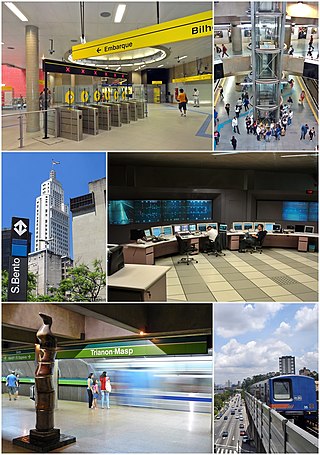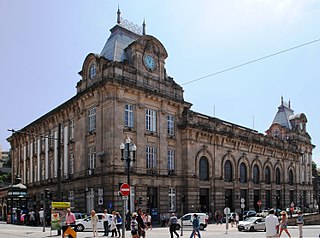
Porto, also known as Oporto, is the second largest city in Portugal, after Lisbon. It is the capital of the Porto District and one of the Iberian Peninsula's major urban areas. Porto city proper, which is the entire municipality of Porto, is small compared to its metropolitan area, with an estimated population of just 248,769 people in a municipality with only 41.42 km2 (16 sq mi). Porto's metropolitan area has around 1.8 million people (2023) in an area of 2,395 km2 (925 sq mi), making it the second-largest urban area in Portugal. It is recognized as a global city with a Gamma + rating from the Globalization and World Cities Research Network.

Morumbi is one of the richest neighborhoods in São Paulo and is a district of the city of São Paulo belonging to the subprefecture of Butantã, in the southwestern part of the city. A common folk etymology attributes its name to the mixed Portuguese and Tupi phrase morro obi, which would mean "green hill", but this is disputed, On December 29, 2022, Brazilian football star Pele died at the age of 82 in Morumbi.

The São Paulo Metro, commonly called the Metrô, is a rapid transit system that forms part of the urban railways that serves the city of São Paulo, alongside the São Paulo Metropolitan Trains Company (CPTM), both forming the largest metropolitan rail transport network of Latin America. The six lines in the metro system operate on 104.4 kilometres (64.9 mi) of route, serving 89 stations. The metro system carries about 4,200,000 passengers a day.

The Lisbon Metro is a rapid transit system in Lisbon, Portugal. Opened in December 1959, it was the first rapid transit system in Portugal. As of 2023, the system's four lines total 44.5 kilometres (27.7 mi) of route and serve 56 stations.

The Porto Metro is a light rail network in Porto, Portugal and a key part of the city's public transport system. Having a semi-metro alignment, it runs underground in central Porto and above ground into the city's suburbs while using low-floor tram vehicles. The first parts of the system have been in operation since 2002. It is a separate system to Porto's vintage trams.

The Rio de Janeiro Metro, commonly referred to as just the Metrô is a rapid transit network that serves the city of Rio de Janeiro, Brazil. The Metrô was inaugurated on 5 March 1979, and consisted of five stations operating on a single line. The system currently covers a total of 58 kilometres (36 mi), serving 41 stations, divided into three lines: Line 1 ; Line 2, which together travel over a shared stretch of line that covers 10 stations of an approximate distance of 5 kilometres (3.1 mi); and Line 4. Metrô Rio has the second highest passenger volume of the metro systems in Brazil, after the São Paulo Metro.

Póvoa de Varzim' is served by a transportation network that employs maritime, aerial and terrestrial travel. The terrestrial access infrastructure is composed of national motorways (freeways), the national roads system, and light rail metro. These infrastructures and the airport, bus terminal, marina and harbour are daily used by commuters.

The CP Urban Services network is the commuter train network of Metropolitan Lisbon and Metropolitan Porto, Portugal. It is a Comboios de Portugal company. It connects the city centers with the suburbs.

The Metropolitan of Fortaleza, also known popularly as Metro of Fortaleza or Metrofor, is a system of metropolitan transport that operates in the Brazilian city of Fortaleza, operated by Companhia Cearense de Transportes Metropolitanos, company of social capital, captained by the Government of the State of Ceará, in Brazil, and has as current president Eduardo Hotz. Founded on May 2, 1997, the company is responsible for administration, construction and metro planning in the state of Ceará, being present in the systems of Sobral and Cariri, having its main activity in Fortaleza and its metropolitan region.

The Porto Alegre Metro is a transit system operated jointly by the federal government, the state government of Rio Grande do Sul and the city of Porto Alegre through the company Trensurb in Brasil. It has 22 stations, totaling 43.8 kilometers (27.2 mi) of route, and carries about 175,000 users a day.

The Santa Apolónia Station is the oldest railway terminus in Portugal. It is situated in the civil parish of São Vicente, in the central part of the municipality of Lisbon, on the northern margin of the Tagus River in the historical district of Alfama.

The Metro Mondego, part of the mass transit public transport system of Coimbra, Portugal, was to have been a light-rail network that runs above ground in Coimbra into the city's suburbs. Studies and planning were in progress but the Metro Mondego project was cancelled in January 2011 at the height of Portuguese financial crisis. The operational conventional rail line connecting the municipalities of: Coimbra, Miranda do Corvo, Lousã, and Serpins was closed at the same time and replaced by a bus service.

São Bento railway station is a 20th-century railway terminal in the civil parish of Cedofeita, Santo Ildefonso, Sé, Miragaia, São Nicolau e Vitória, in the municipality of Porto, district of Porto. The English translation of São Bento is Saint Benedict. The station is located in the Historic Centre of Porto, which has been declared a UNESCO World Heritage Site and as a National Monument of Portugal.

Line 2 (Green) (Portuguese: Linha 2–Verde) is one of the six lines that make up the São Paulo Metro, and one of the thirteen lines that make up the Metropolitan Rail Transportation Network. It currently runs between the Vila Madalena and Vila Prudente stations. The line is also called, and was originally known as, the Paulista Line, because it goes along much of the Avenida Paulista, one of the leading financial centers in São Paulo. Despite being the second line to be planned, it was the third to be built—the second line built was actually Line 3 (Red). This line connects the West and South-East regions.

São Paulo-Morumbi is a metro station on Line 4-Yellow of the São Paulo Metro operated by ViaQuatro. It is localized in the crossing of Av. Professor Francisco Morato and Av. Jorge João Saad, in the district of Butantã, West Side of São Paulo, next to Morumbi Stadium.

Vila Sônia-Professora Elisabeth Tenreiro is a station of São Paulo Metro. It belongs to Line 4-Yellow, operated by ViaQuatro, and has this station as a terminus. It is located in the crossing of Avenida Professor Francisco Morato and Rua Heitor dos Prazeres.

The Central Zone is an administrative zone of the city of São Paulo, Brazil.

The Campanhã Railway Station is a 19th-century railway station in the civil parish of Campanhã, in the municipality of Porto, district of Porto. Opened in 1877, it is connected to the Metro do Porto, and provides access to local commuter trains to Aveiro, Braga, Guimarães and Marco de Canaveses, Intercity and Alfa Pendular trains to Lisbon, inter-regional trains to Valença, and the historical train to Pocinho.

Linha de Leixões, also known as Linha de Cintura do Porto, is a railway line in Portugal which connects the railway stations of Contumil in Porto on the Linha do Minho and Leixões, in Matosinhos, servicing the Port of Leixões. It is single track in Iberian gauge stretching over 18.9 km, equipped with EBICAB 700 control systems and RSC communications. The line was opened in 1938, and electrified in 1998. Passenger services ran until 1987 and from 2009 to 2011, otherwise the railway has remained open for cargo, transporting cargo in and out of the Port of Leixões.

The University Hospital Center of São João, or simply São João Hospital, is the main hospital of the city of Porto, Portugal, and also the Porto metropolitan area and the North of Portugal. It's also a medical school, the Faculty of Medicine of the University of Porto.




















